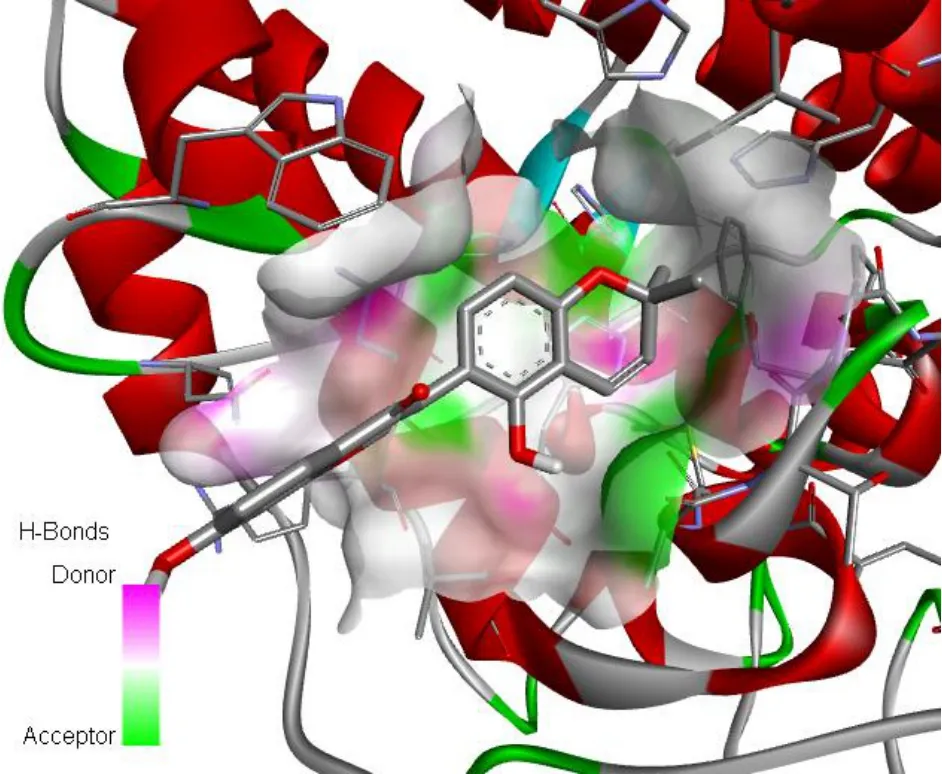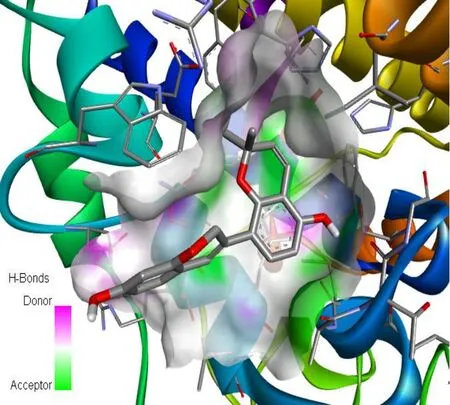Molecular docking analysis to validate the efficacy of phytocompounds of traditional Siddha herb Glycyrrhiza glabra against enzyme tyrosinase for the treatment of vitiligo
Gurumurthy Arthi,Venkatachalam Lakshmanakumar,Jayaraj Rathinam,Dhanasekaran Sivaraman
1Sai Siddha Clinic,Salem,Tamil Nadu 636354,India. 2Department of Siddha,All India Institute of Medical Sciences Raipur,Chhattisgarh 492099,India. 3GUPHC,Eriyamangalam,Namakkal,Tamil Nadu 637210,India. 4Department of Biotechnology,Pandit Deenadayal Energy University,Knowledge Corridor,Raisan Village,PDPU Road,Gandhi Nagar,Gujarat 382426,India.
Abstract Background:Siddha system is one of the ancient medical systems which originated in India more than 4000 years ago had given many formularies and treatment methods for various diseases especially skin diseases and autoimmune diseases. One of the most well-known members of the Fabaceae family and a popular medicinal plant is Athimathuram(Glycyrrhiza glabra). Glycyrrhiza glabra root powder (Athimathuram chooranam) from Siddha herbal formulation mentioned in the texts to treat vitiligo. The study is aimed to execute the In Silico computational studies of phytoconstituents of Siddha herb Athimathuram chooranam (Glycyrrhiza glabra) against Tyrosinase enzyme for the treatment of vitiligo. Method: Making use of Auto Dock 4, docking calculations were performed.Gasteiger partial charges were applied to the ligand atoms.In order to simulate docking,the Solis & Wets local search approach and the Lamarckian genetic algorithm were employed.The ligand molecules’ initial locations, orientations, and torsion angles were determined at random. During docking, all rotatable torsions were freed. Results: By interacting with amino acids located on the active site of the tyrosinase enzyme, bioactive substances like Glycyrrhizin, Liquirtin, Glabridin, Umbelliferone, and Glabrene included in the Siddha formulation exhibit substantial binding activity against the target protein. Conclusion: It was concluded that these compounds might exert promising anti-vitiligo properties.
Keywords: Glycyrrhiza glabra; Athimathuram chooranam; vitiligo; molecular docking;Siddha
Introduction
The Siddha system of medicine is one of the ancient traditional medicines in the world. Siddha’s system of medicine has the best medicines to treat various skin diseases [1]. Several Siddha medicines are indicated for Vitiligo (venpulli) in Siddha literature. A skin condition called Vitiligo (pronounced vit-il-EYE-go) results in the skin losing its color.On a person,soft white spots start showing up on their skin. The disease is started by the body’s immune system destroying melanocytes, the skin cells that synthesize melanin, the pigment that gives skin its colour. The causes of Vitiligo are Genetics, Autoimmune response Oxidative stress and Environmental factors.The typical onset of Vitiligo is a few little white spots that may progressively expand across the body over several months[2].However,Vitiligo can appear anywhere on the body, including the mucous membranes (wet lining of the mouth, nose, genital, and rectal areas), the eyes, and the inner ears.The larger patches can occasionally keep growing and spreading,but they mostly remain in one spot for years. As specific parts of the skin lose and gain pigment, the location of smaller macules varies and changes over time.The amount of skin affected by Vitiligo varies,with some people having only a few depigmented spots and others having a significant loss of skin colour. Tyrosinase is a copper-containing enzyme in plant and animal tissues that catalyzes the production of melanin and other pigments from tyrosine by oxidation. It is found inside melanosomes which are synthesized in the skin melanocytes.Glycyrrhiza glabra(Athimathuram) is indicated for the treatment of Vitiligo (Venpulli) in Siddha literature [3–7].Glycyrrhiza glabrais described as a skin depigmentation agent and is incorporated into topical products for that purpose [4]. In this Research work,Athimathuram(Glycyrrhiza glabra)has been evaluated for its potential therapeutic agent for the management of Vitiligo by Docking studies.
Medicine preparation
Athimathuram chooranam (AC): Athimathuram (Glycyrrhiza glabra root) is Purified and made into powder &sieved in a cotton cloth. The Prepared chooranam is safely kept in an Air-tight container [5].
Objective
The main objective of the study is to find the lead molecules to bind with these core bioactive amino acid residues His38, His54, His63,His190, His194, and His216 which mediates the enzymatic action of the enzyme called tyrosinase, thereby it tends to enhance/synergies the action of tyrosinase enzyme to improve the action of melanogenesis. In general, melanin pigment production was found to be deprived in hypopigmentation medical conditions like vitiligo, so improving tyrosinase activity helps to achieve melanogenesis in conditions like vitiligo.
The crystalline structure of the target protein Tyrosinase with PDB 1WX3 was retrieved from the protein data bank (PDB), protein clean-up process was done, and essential missing hydrogen atoms were added. The Auto dock algorithm assessed various lead molecule orientations concerning the target protein,and the best dock pose was chosen based on the interaction study results.
Methodology
Table 1 describes the phytocomponents selected for docking. Table 2 shows the target molecule tyrosinase. Making use of Auto Dock 4,docking calculations were performed. To the ligand atoms, Gasteiger partial charges were added. Non-polar hydrogen atoms were merged,and rotatable bonds were defined. Docking calculations were performed for the retrieved photo components against the target protein Tyrosinase with PDB 1WX3. With AutoDock tools, necessary hydrogen atoms, Kollman unified atom type charges, and solvation parameters were added (Morris, Goodsell, et al., 1998). The Auto grid application produced affinity(grid)maps with grid points and spacing of 0.375 (Morris, Goodsell, et al., 1998). The van der Waals and electrostatic components were computed using Auto Dock parameter set- and distance-dependent dielectric functions, respectively [8]. The Lamarckian Genetic Algorithm and the Solis & Wets local search approach were used to simulate docking (Solis and Wets, 1981). The ligand molecules’ initial positions, orientations, and torsion were determined randomly. During docking, all rotatable torsions were released [9]. Each docking experiment was constructed from two separate runs, each programmed to end after a maximum of 250,000 energy assessments. The population was limited to 150 people. A translational step of 0.2 and quaternion and torsion steps of 5 were used during the search [10].
Observation and Inference
Figure 1 shows the target molecule tyrosinase (1WX3) receptor structure. A total of 6 bioactive lead compounds were retrieved from the herbs present in the Siddha formulation. Figure 2i Glycyrrhizin,Figure 2ii Liquirtin, Figure 2iii Glabridin Figure 2iv Glabrone, Figure 2v Umbelliferone and Figure 2vi Glabrene shows 2D and 3D structure of phytocomponents respectively. From the reported data of the herb,the leads such as Glycyrrhizin,Liquirtin,Glabridin,Umbelliferone and Glabrene possess 2–4 interactions with 30–60% binding efficacy by interacting with core target amino acids (His38, His54, His190,His194) present on the protein Tyrosinase enzyme. Table 3 represents the Ligand Properties of the Phytocomponents Selected for Docking Analysis of Athimathura Chooranam. Table 4 shows the phytocomponents of AC against 1WX3. Amino acid Residue Interaction of Phytocomponents of AC against 1WX3 shows in Table 5.Figure 3a–3c denotes Glycyrrhizin with 1WX3, Interaction plot analysis and Hydrogen bond plotting analysis with core amnio acids respectively. Figure 4a–4c shows Liquirtin with 1WX3, Interaction plot analysis and Hydrogen bond interaction respectively. Figure 5a–5c represents Glabridin with 1WX3, Interaction plot analysis and Hydrogen bond interaction respectively.Figure 6a–6c shows Glabridin with 1WX3, Interaction plot analysis and Hydrogen bond interaction respectively. Figure 7a–7c shows Umbelliferone with 1WX3,Interaction plot analysis and Hydrogen bond interaction respectively.Figure 8a–8c represents Glabrene with 1WX3,Interaction plot analysis and Hydrogen bond interaction respectively.
Conclusion
Based on the results of the computational analysis, it was concluded that the bio-active compound’s like Glycyrrhizin, Liquirtin, Glabridin,Umbelliferone and Glabrene present in the Siddha herbal formulation Athimathuram chooranam revels significant binding against the target protein by interacting with amino acid present on the active site of the tyrosinase enzyme thereby it was concluded that these compounds might exert promising anti-vitiligo property by synergizing the action of tyrosinase enzyme to improve the melanogenesis so that in turn improves melanin pigment production which was found to be deprived in hypopigmentation medical condition like vitiligo. Further pharmacological studies and clinical trials are needed to establish that the drug Athimadhura Chooranam is efficacious in treating vitiligo.

Table1 List of phytocomponents selected for docking

Table 2 Name of target molecule

Figure 1 Tyrosinase(1WX3) receptor structure

Figure 2i Glycyrrhizin.2D and 3D Structure of phytocomponents.

Figure 2ii Liquirtin.2D and 3D Structure of phytocomponents.

Figure 2iii Glabridin.2D and 3D Structure of phytocomponents.

Figure 2iv Glabrone.2D and 3D structure of phytocomponents.

Figure 2v Umbelliferone.2D and 3D structure of phytocomponents.

Figure 2vi Glabrene.2D and 3D Structure of phytocomponents.

Table 3 Ligand properties of the compounds selected for docking analysis

Table 4 Summary of the molecular docking studies of compounds against tyrosinase(1WX3)

Figure 3a Docking Pose Glycyrrhizin with Tyrosinase(PDB)-1WX3

Figure 3b Interaction plot

Figure 3c Hydrogen bond interaction

Figure 4a Liquirtin with Tyrosinase (PDB)-1WX3

Table 5 Amino acid residue interaction of phytocomponents against tyrosinase (1WX3)

Figure 4b 2D Interaction Plot

Figure 4c Hydrogen bond interaction

Figure 5a Glabridin with Tyrosinase(PDB)-1WX3

Figure 5b 2D Interaction Plot

Figure 5c Hydrogen bond interaction

Figure 6a Glabrone with Tyrosinase (PDB)-1WX3

Figure 6c Hydrogen bond Interaction

Figure 7a Umbelliferone with Tyrosinase (PDB)-1WX3

Figure7b 2D Interaction Plot Analysis

Figure 7c Hydrogen bond Interaction

Figure 8a Glabrene with Tyrosinase(PDB)-1WX3

Figure 8b 2D Interaction Plot

Figure 8c Hydrogen bond Interaction
